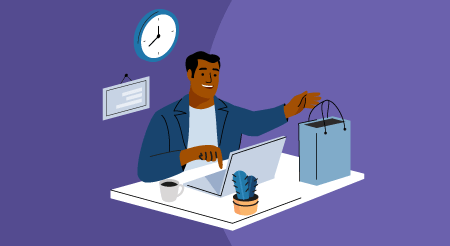As a retailer (and a consumer), you know better than anyone how important a good customer experience is. Over the last few years, one change retailers have made to improve the customer experience is to offer click and collect, also known as buy online, pick up in-store (BOPIS).
This form of order fulfillment isn’t exactly new; drive-ins perfected the art of delivering a customer’s order straight to their driver-side window nearly 100 years ago. But it is becoming an order fulfillment option that customers expect, and retailers that fail to adapt will lose business to those who do.
Click and collect isn’t just good for customers—it’s good for your bottom line, too; Software Advice surveyed over 700 U.S. retailers in May and found that 42% rank pick up in-store/click and collect as their top sales driver over the previous 12 months.
So whether you’re ready to start offering click and collect at your retail business tomorrow or you’re still weighing the pros and cons, there’s a lot left to learn. That’s why we’ve put together this guide to help you see how click and collect can work for your business.
What is click and collect?
Click and collect is when a consumer purchases an item online and picks it up at a designated location. It is a fulfillment service offered by retailers that combines elements of ecommerce and brick-and-mortar shopping; customers can choose what they want to buy online with their mobile device or computer, then visit the store in-person to collect their order.
Examples of click-and-collect services include:
- Curbside pickup for online orders.
- Ship-to-store or in-store pickup (either at a designated counter or locker station).
- Remote pickup (usually at an affiliated partner location such as a UPS, FedEx, post office, or Amazon hub locker).
Here’s why you should offer click and collect
Click and collect makes the shopping experience more convenient for consumers. They can make purchase decisions from the comfort of their home or on the go, then collect their items at any time. They can also save money with click and collect by avoiding shipping and delivery costs.
But if a better customer experience isn’t enough to convince you to adopt click and collect, let’s take a look at the numbers: When asked how they’re prioritizing different business goals over the next 12 months, 39% of retailers say they are permanently increasing the priority of delivery and fulfillment strategies.

Lastly, out of those 700+ retailers, only 5% state that they haven’t and don’t plan to implement click and collect as a fulfillment strategy.
And while this trend is partially due to the COVID-19 pandemic, it’s customer preference that’s driving the permanent shift: A survey conducted by Incisiv late last year found that 80% of shoppers expect to increase their use of BOPIS and curbside pickup over the next six months.
All of this means that retailers recognize the financial benefits of offering click and collect and are responding by investing further in their fulfillment systems. And with the vast majority (95%) of retailers already implementing or planning to implement BOPIS, if you aren’t, you will have trouble competing.
How to make click and collect work at your retail business
Let’s take a look at the four basic steps that occur in click and collect:

Once your business is set up to manage these four steps, it’s smooth sailing from there. Here are some tips on how to optimize your business for the above steps.
Designate an ordering system
If you’re serious about offering click and collect as a permanent order fulfillment option, you’ll need an online store so you can capture customer orders. If you already have a website, it’s pretty easy to integrate an ecommerce platform into your existing site. But if you don’t, not to worry—website builders come with templates for branded storefronts that will have you online in no time.

Customers are prompted to pick a date and time for pickup with Shopify (Source)
Plus, many popular ecommerce tools are built with functionality that supports BOPIS, such as customizable pickup hours and order confirmation notifications.
Create an internal process for fulfilling click-and-collect orders
Once you’re set up to capture orders online, the next step is to create an internal process for fulfilling orders. This will ensure your employees have a step-by-step plan for receiving, fulfilling, and delivering orders to the right collection point.
This step will require some forethought, which is why we’ve put together a list of questions to consider while developing your internal process:
- Who will be responsible for receiving and fulfilling orders?
- How long will it take to package an order so it’s ready for pickup?
- What is the turnaround time goal for a new order?
- What will the pickup deadline for an online order be?
- How will you denote if an order has been picked up in your POS system?
- Where in the store will you set up the designated pickup location?
When you’ve ironed out these details, document your proposed internal process and share it with your employees. Then, hold a training session with your staff to run through the process a few times and answer any questions they may have.
Design an in-store experience for BOPIS orders
Imagine that you’re a customer who has placed an online order for pickup. Checkout was easy, but then you arrive at the store with no instructions for how to collect your order. Confusion ensues, and you end up spending more time than you hoped to figuring out how to pick up your goods.
This is not the experience you want your customers to have. Statista found that 50% of consumers cite convenience as the main reason for choosing curbside pickup, which means that your click-and-collect experience should be as straightforward and easy as possible.
To accomplish this, make sure you have these three essential components:
- Signage that directs customers to the appropriate pickup location. If you’re opting for curbside delivery, designate a row of parking spots for customers to wait for their order. If customers need to retrieve their order inside your store, decide whether they should do this at a regular checkout line or a separate counter.
- Clear instructions for how shoppers should proceed when they arrive. If you’re opting for curbside delivery, we recommend setting up a phone number customers can text to let your team know they’ve arrived. SMS marketing software can help with this. Additionally, decide if your customers need to provide certain information for verification purposes, such as their order number or a valid photo ID.
- Dedicated team members ready to assist customers with their orders. Finally, you should have an employee (or a team of them, depending on the size of your business) overseeing BOPIS orders. They should be responsible for making sure customers receive their items, that their orders are correct, and that any questions they have are answered to the best of your employees’ ability.

Signage for mobile order pickup at a Starbucks (Source)
Prepare for the future of retail today with these resources
With these elements in place and your internal process ironed out, you should be ready to offer click and collect to your customers.
Deploying a click-and-collect strategy is one way to keep up with your competition while catering to your customers’ needs, but there’s even more you can do. Stay up to date on the latest retail trends with these articles:
When you’re ready to start researching software to help with your click-and-collect transition, our advisors are here to help. You can schedule a call or chat to discuss factors such as the features you need and what you’re willing to pay, and at the end of the conversation you’ll receive a short list of products that match your criteria.
Survey methodology
Software Advice conducted the 2021 Retail Comeback Survey in May 2021. We surveyed 703 retailers of up to 10,000 employees to learn more about the current trends, challenges, and market changes in the retail industry, as well as how they have adapted their fulfillment models and payment options. Seventy-five percent were retailers with up to 500 employees.
Note: The applications selected in this article are examples to show a feature in context and are not intended as endorsements or recommendations. They have been obtained from sources believed to be reliable at the time of publication.
[adsanity_group align=’alignnone’ num_ads=1 num_columns=1 group_ids=’15192′]
Need Any Technology Assistance? Call Pursho @ 0731-6725516




